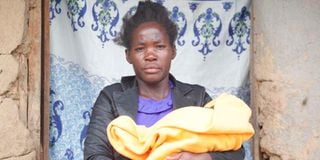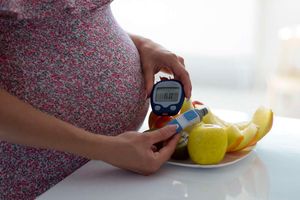At long last! Bundle of joy after three pregnancy losses

Jackline Ondebo and her two-month-old daughter at their home in Shikoti Village, Kakamega County.
What you need to know:
- A high-risk pregnancy is one that involves increased health risk for either the mother or the unborn baby, or both.
- This occurs mostly when the woman is 35 years or older, or younger than 17 at conception. It is also common for mothers with a history of pre-term labour and those carrying more than one baby.
Jackline Ondiebo smiles broadly with every glance at her two-month-old baby, Scholastica Nerima. This birth has been both joy and relief after the frustrations of losing three earlier pregnancies.
From being unable to sustain a pregnancy to broken relationships and ridicule and stigma from her community, the 32-year-old has experienced the darkest side of childlessness for eight years.
“Scholastica is my world, a miracle sent by God to wipe away my tears,” says Jackline excitedly.
Since 2013, Jackline has had three miscarriages at between 12 and 34 weeks, leaving her devastated.
When she lays her baby to bed, it is difficult for Jackline to mask her delight. The successful pregnancy, she says, was thanks to regular antenatal care (ANC) visits and keenly following her gynaecologist’s advice being a high-risk mother.
In 2013, then aged 23, Jackline got married and began her search for a child. Later that year, she would conceive, putting her in the path of motherhood.
But luck was not on her side. “One day while at home I started spotting. I was also experiencing sharp headaches and backaches. I had to be moved to Central Nursing Hospital in Kitale and placed on bedrest. I was, however, discharged the following day,” she recounts.
During Christmas celebrations that year, trouble began. “My back stabbed and my abdomen started aching. I was bleeding and had to be rushed to the hospital on a motorcycle,” she adds.
By the time she got to hospital, she had lost her baby at 24 weeks. The young mother had also lost a lot of blood and had to be transfused, with doctors recommending another bedrest.
Even as she left the hospital, Jackline could not comprehend the circumstances under which she had lost her baby.
Subsequent attempts to get a baby ended in similar fashion: miscarriage.
In 2019, she conceived again and soon her back pains were back. She would be booked for an ultrasound and placed on drugs but had to be admitted at Kakamega Referral Hospital, where doctors would attend to her nearly 10 hours later.
‘‘I woke up in a pool of blood,” she says, adding that fibroids caused her miscarriage. ‘‘I would wait for two days to have my uterus cleaned.’’
A devastated Jackline would part ways with her husband owing to conflict with his family and travel to Nairobi for work. In the city, she met a suitor. In 2020, seven years after her first pregnancy, she was pregnant for the third time, a pregnancy that lasted only three months.
“The doctors knew I had fibroids. But I was never advised on the best care to avoid future miscarriage,’’ she laments, blaming the medics for negligence.
But it is the stigma from childlessness from her community that traumatised her even more, complicating her recovery journey. ‘‘Some women avoided me lest ‘I infect them with the problem’.’’
Later, doctors advised her against carrying a pregnancy to avoid putting herself at risk. But she was determined to have a baby. Last year, she met another lover.
“When I leant that I was pregnant, I was scared. The thought of a possible miscarriage could not leave me,” she says.
At St Elizabeth Mukumu Mission Hospital in Kakamega’ where she went for ANC visits, doctors identified hers as a high-risk pregnancy based on her previous experiences.
A high-risk pregnancy is one that involves increased health risk for either the mother or the unborn baby, or both. This occurs mostly when the woman is 35 years or older, or younger than 17 at conception. It is also common for mothers with a history of pre-term labour and those carrying more than one baby.
Those suffering from pre-eclampsia, fibroids, diabetes, kidney diseases and high blood pressure autoimmune diseases, and even Covid-19, are at a higher risk.
Such pregnancies require close monitoring of the expectant woman to forestall complications or death.
Having been diagnosed with fibroids and triple miscarriages, Jackline was marked as a high-risk mother and was immediately enrolled in the facility’s MomCare programme that supports mothers throughout their pregnancy. Funded by PharmAccess Foundation, the initiative also provides financial support to mothers. Western Region MomCare Programme Coordinator Moses Otieno says 19 health facilities in Kisumu and Kakamega have signed up. The two counties are among those with a higher burden of maternal-child deaths.
MomCare provides technical assistance to facilities implementing the programme and enables health facilities to acquire all the ANC care clinics at a one-stop-shop to minimise hospital visits.
“Our aim is to reduce maternal and natal deaths; we highly recommend regular ANC visits to achieve our goal,’’ Moses tells Healthy Nation.
Thanks to the programme, Jackline would acquire the best possible care. Throughout her pregnancy, she was hospitalised eight times before delivering her daughter, healthy and safe.
Dr Mercy Omondi, the hospital’s medical officer in-charge, says high-risk mothers visiting the clinic are placed on routine examination for any signs of complication without charges.
“During every clinic visit, we take them through lessons on identifying dangers to their pregnancy and encourage them to report them. We also record the medical history of the expectant mother,’’ says Dr Omondi, adding that the programme has seen ANC clinic attendance by mothers improve, with only few home births.
The World Health Organization (WHO) report shows that 810 women die every day from preventable causes related to pregnancy and childbirth. Those living in rural and remote areas, and with less economic means, are at higher risk.
WHO, however, insists that most maternal and natal deaths are preventable, especially with timely management by a skilled professional working in a supportive environment.





